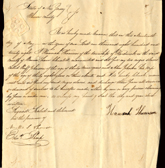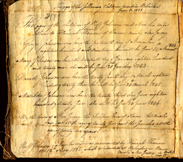|
Manumission of Ann and Rufus
Johnson,1828
Courtesy, New Jersey Historical Society,
Newark, NJ
Anderson Family Papers, MG 608, folder 27 "Johnson Family Records"
|
 |
 |
Ann and Rufus Johnson were 14 and 15
years old respectively when New Jersey enacted gradual manumission in 1804. They, however, were not positively affected by the law. Slavery took the best years of their working lives in service to their owner, Hannah Thomson, before she freed them in
1828. (Manumission document: upper left.) Their four young children were not slaves, but they were required by law to work for Thomson for many years. Mary (age 7) and Matilda (age 3) were required to work for their parentsí former owner until they were 21; George (age 9) and David (age 5) were required to work until they were 25. Hannah Thomson did not free the children from these obligations when she freed their parents.
(Document showing ages of children: upper right.)
It isnít known what motives and conditions lay behind the facts of these two legal documents. Were Ann and Rufus going to continue to work for Thomson, but for wages? Would their small children be cared for by their former owner or would the freed parents be expected to bear the cost of their childrenís up-keep? Would the family live together or be separated? Why did Thomson not relinquish her right to the indentures of the children, as other owners often did
when small children were involved? Were Ann and Rufus skilled workers who would be able to find work elsewhere, or were they destined for a life of menial labor for low wages? Gradual manumission softened the economic impact of abolition for slave owners, but for slaves and their children, in the short term, the law was a very mixed blessing.
|